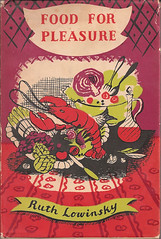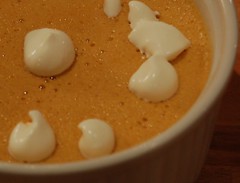As I mentioned in my last post, Food for Pleasure was published in 1950, when Britain was still subject to rationing, albeit less drastic than during the war. It’s actually an anthology; Ruth Lowinsky chose recipes from books published from 1866 to 1942, including some of her own. So it’s even more old-fashioned than it sounds! “Pre-war cookery books,” she says, “must not be thought obsolete: their recipes, even when modified, offer incomparably better results than the frightening suggestions devised to suit the times by the misplaced ingenuity of the Ministry of Food.”
Just to encourage us, she adds, “Do not throw up your hands in histrionic despair when inferior ingredients result in a dish that falls short of your old, exacting standards”. With true British sangfroid, she urges us to make do and mend. “You must have forgotten how good things taste when cooked in butter. Continue to forget, and use instead margarine or margarine mixed with lard.” Those were the days!
Then she gives us some suggested menus, with quaint titles such as Luncheons for guests on whom a special effort is not wasted (cold mousse of eggs, duck with turnips, purée à la Jane); A dinner to please your husband who has invited business friends and wants to impress them (Batavia frappé, chicken à la king, salade andalouse, raspberry ice); Little dinners for the girl who lives alone and has a guest (Eggs à la bonne femme, boeuf Stroganoff, camembert in aspic – whaaaaat??).
As for the recipes, there was no Delia in those days. No glossy photos, and usually there are no quantities of anything, except for cake or pastry recipes – just a list of ingredients. The author assumes you already know how to cook from scratch, so most recipes are very short, with just basic instructions. Though indubitably British, they are also very foreign to modern tastes; there were quite a few I read several times and just couldn’t visualise what they would be like (on the other hand, it’s perhaps a good thing that I can’t imagine what camembert in aspic is like). A dish called panna consisting of cooked spinach, hard-boiled eggs, sardines, anchovies, and butter, all pounded together, sieved, spread out on a tray, and then cut into rounds and served on ice had me scratching my head too.
Apart from aberrations like these, it’s clear that in general British food in the 1950s was much blander than modern food. Or to put it another way, “things taste of what they are,” as Curnonsky famously said. Very few herbs and spices are used, and certainly no Asian ingredients. Naturally there are a few mild curries, and other dishes are given a bit of zing with nothing more exotic than mustard, anchovies, horseradish, or chutney.
So, something simple for pre-dinner nibbles: Parmesan fingers, courtesy of Mrs Winston Churchill, no less. Very easy to make: you just cut some stale white bread into finger-sized pieces, soak them in cream as if you were making pain perdu without the eggs, and then roll them in a mixture of finely grated Parmesan and black pepper. In the spirit of wartime substitution, you can use Gruyère or Cheddar instead. Then arrange on a greased baking sheet and bake in a hot oven for about 15 minutes, turning once, until both sides are nicely browned. I used not-very-stale sourdough baguette, whereas I think the recipe assumes factory-made white sliced, so my “fingers” came out looking rather messy. But they were very good eaten piping hot, creamy on the inside and crispy on the outside. I’d do these again.
Then cream of carrot soup. This is a prime example of 1950s blandness. It was a lovely pale apricot colour, and tasted of carrots. Which is OK I suppose, but nowadays you would have to perk it up with coriander, ginger, or orange.
Looks appetizing, doesn’t it?
The geography of the dish I chose for the main course seemed a bit amiss. Brazilian Stew (or Goulash, in Hungary) it said. Well, they are both foreign I suppose. It wasn’t much like any goulash I’ve ever had, because there was no paprika in it, at all. It’s basically a very British beef stew, with winter vegetables (potatoes, carrots, onion, a turnip), tomatoes, and beef, which for some reason is dipped in vinegar before adding it. I think this might be considered to be an adequate substitute for wine. No other liquid at all, except what comes out of the ingredients themselves.
It’s supposed to stew “at the back of the fire” for three to four hours, so I put my big cast-iron cocotte on top of the woodburner, pouring some cold water into the concave lid so that what liquid there was inside would condense and drip back down onto the meat. Result: lots of excellent gravy. Again, I think it could be enlivened with some more seasonings: a smidgin more vinegar, some Worcester sauce – heck, you could even put paprika in it and call it goulash!
Pudding: with 1950s English cuisine, it had to be jelly. Well, soufflé froid au caramel actually. This must be a pre-war recipe as it is rather extravagant with eggs. It is made in the same way as you would make zabaglione, only without the marsala – whisking eggs and sugar over hot water until thick and creamy. Then some caramel and gelatine are added and you pour it into a soufflé dish to set. Unfortunately my dish was a bit big, so I couldn’t do the paper collar thing to make it look as if it had risen above the top of the dish. Instead I just put it in the fridge and hoped for the best. It tasted good, except that it separated as it set, so I ended up with a dense caramelly bottom layer and a fluffy top layer. If I made it again, I would do it in individual moulds as it looked a total mess once it was dished out.
All in all we enjoyed this meal; nothing was startlingly good, but it was plain, wholesome stuff, made with ingredients that are all cheap and easy to obtain. I can definitely envisage making the Parmesan fingers again; really easy to do with ingredients you are likely to have on hand. My adaptations of the other two recipes follow.
Brazilian stew (or Goulash, in Hungary)
1 kg stewing beef (I used paleron, which is silverside in English I think; any cut suitable for slow cooking will do)
3 tbs red wine vinegar
1 tbs flour
1medium onion
2 turnips
4 carrots
4 large potatoes plus a few small ones
3 tomatoes
A stick of celery plus the leaves
Dripping or oil (the recipe specified beef dripping, but that’s not something I have to hand; I used duck fat instead)
Salt and pepper
Paprika or Worcester sauce to taste
I’m sure this recipe would work really well in a slow cooker.
Put the vinegar in a bowl. Cut the meat into fairly large chunks, at least an inch square, and toss them in the vinegar. Slice the vegetables, except the potatoes, and cut up the tomatoes. Peel the large potatoes. Melt the dripping in a large, heavy casserole and add all the sliced vegetables, and the tomatoes. Saute for a few minutes, till they start to soften and release some juice, then sprinkle on the flour and cook for a few minutes more, stirring, till they are slightly coloured. Add the meat, the peeled large potatoes, and the celery leaves, and season generously. Cover tightly and cook over a very low heat for 3-4 hours. An hour before it’s done, add the small potatoes, peeled but left whole, and put the lid back on. When the meat is really tender and the potatoes are cooked, taste and season further if necessary. It really doesn’t need anything else with it, although a green vegetable would be a good idea.
Soufflé froid au caramel
Caramel:
150 g sugar (cubes are best)
3 tbs cold water
Soufflé:
100 g caster sugar
3 eggs and 2 yolks
2 ¼ leaves gelatine
juice of ½ a lemon
2 tbs very hot water
3 tbs whipped cream
Note: the original recipe instructs you to stir the soufflé over ice till almost set, before pouring it into the mould. I didn’t do this because I didn’t have any ice; I just put it in a sink of cold water. But I think if I’d used ice it probably wouldn’t have separated, because it would have cooled much faster and I wouldn’t have had to spend so much time stirring. So have some ice handy. Also, this all sounds more trouble than it is; it’s really quite quick to make (especially if you cheat and use bought caramel!).
Use the sugar to make caramel in a dry pan. When it’s done, protect your hand from any splashes and pour in the 3 tbs water. Return to the heat and stir till smooth if it seizes. Set aside.
Prepare 4 individual ramekins by tying strips of oiled greaseproof paper round them so that they protrude above the rim. Put the sheets of gelatine to soak in some cold water.
For the soufflé base, put the eggs and yolks in a bowl with the sugar over a pan of barely simmering water. Using an electric whisk, beat constantly for about 10 minutes until the mixture is thick and frothy, and the whisk leaves a trail on the top. It won’t be hot, but should be warm. Remove from the heat and start adding the caramel, still whisking. Taste as you go, till it seems caramelly enough. Whisk in 1 tablespoon of whipped cream.
Squeeze out the gelatine and add it to the hot water and lemon juice in a small bowl, stirring to dissolve (the egg mixture isn’t hot enough for this, which is why you have to do it separately). Then whisk it into the eggs. Put the bowl inside another bowl filled with ice, and stir until it is almost set. Then pour it into the moulds, using the paper to fill a bit above the edges, and put them in the fridge to finish setting.
Carefully remove the oiled paper, and decorate the soufflés with the remaining whipped cream. You can use other flavourings instead of caramel – praline or coffee for example, or even pureed fruit. Be careful not to increase the amount of liquid added though, or it won’t set.



What a great idea – the menu sounds very interesting. Have you seen the program by Valentine Warner called Ration Book Britain where he cooks old ministry of food recipes from WWII? It was on the digital channel ‘Yesterday’ last week but will probably be repeated again soon, they are also showing Wartime Kitchen and Garden with is also about cooking with rations, making do and supplimenting it with growing veg. Very interesting programs if you get the chance to watch them. I look forward to your next challange menu.
I don’t get UK TV here, so I haven’t seen them. Shame, they sound interesting. I really do enjoy browsing through old cookbooks!